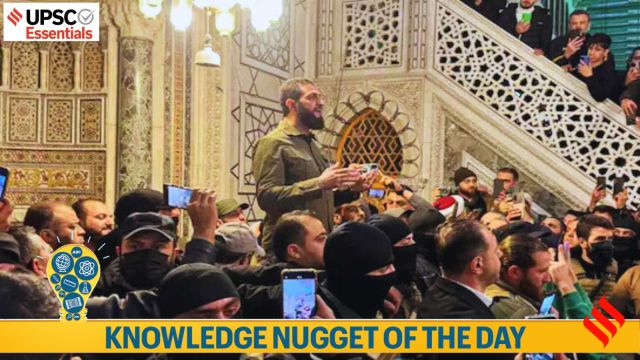The Syrian civil war has seen major developments in recent days. The government of President Bashar al-Assad, who ruled the Middle Eastern country since 2000, has reeled under sudden intense attacks from the rebel group Hayat Tahrir al-Sham. On Sunday (December 8), its members reached the capital Damascus and celebrated the fall of the regime led by Assad, who was reported to have fled the country.

Key Takeaways :
1. The Hayat Tahrir al-Sham (HTS), which Abu Mohammad al-Jolani leads, was founded in 2011 as Jabhat al-Nusra, the al-Qaeda’s branch in Syria. In 2016, it broke away to form the Jabhat Fateh al-Shaam (JFS), standing for the liberation of Shaam or the Levant (the sub-region of the Middle East lying near the Mediterranean Sea, including Jordan, Syria, Lebanon, Israel and Palestine).
2. Bashir Ali Abbas, a Research Associate at the Council for Strategic and Defense Research, New Delhi, wrote in The Indian Express, “By 2017, after merging with a number of other groups, the JFS became the HTS, which had a localized operational focus distinct from al-Qaeda’s global jihadist outlook.”
3. The group has controlled much of northwest Syria, and also set up a “salvation government” in 2017 to run day-to-day affairs in the region.
4. After a cease-fire brokered by Russia and Turkey in 2020 generated an uneasy calm in northwestern Syria, the group took the opportunity to restructure its forces, becoming more professional with better training and weapons. Slowly, other rebel organisations merged with them, making them the largest force in northwestern Syria.
5. The group is said to be driven by the jihadist ideology. However, by appointing Mohammad al-Bashir to the head of the “transitional” government of Syria, the HTS has sought to follow the example of Abdul Hakim bil Hajj’s Libya Islamic Fighting Group and is rebranding itself as a regional, pragmatic, and somewhat nationalist force, positioning itself as an ally of the West.
Story continues below this ad
6. Abu Mohammad al-Jolani has personally reached out to neighbouring governments in Baghdad and Beirut, calling for good relations, even offering Syria’s services to the international community in identifying Assad’s chemical weapons remnants. (The Taliban were quick to congratulate Syrians after Assad’s fall.)
Syrian Civil War
The Syrian civil war began around the “Arab Spring” of 2010, dubbed so as many countries in the Middle East and North Africa saw uprisings against authoritarian governments that had been in power for decades. Foreign governments, such as the United States and Russia, also engaged with the conflict based on their respective strategic interests.
 CORRECTS SPELLING Syrian opposition fighters pose for a photograph as they celebrate at Umayyad Square in Aleppo, Syria, Monday, Dec. 9, 2024. (AP Photo/Omar Sanadiki)
CORRECTS SPELLING Syrian opposition fighters pose for a photograph as they celebrate at Umayyad Square in Aleppo, Syria, Monday, Dec. 9, 2024. (AP Photo/Omar Sanadiki)
BEYOND THE NUGGET: Other groups of the region which often see in news
Hezbollah
1. Hezbollah translates to “Party of God”. The Centre for Strategic and International Studies (CSIS) has previously described it as “The world’s most heavily armed non-state actor, with a large and diverse stockpile of unguided artillery rockets, as well as ballistic, antiair, antitank, and antiship missiles.”
Story continues below this ad
2. Hezbollah originated during the Lebanese Civil War (1975-1990), which was a result of “long-simmering discontent over the large, armed Palestinian presence in the country”, according to the Council on Foreign Relations (CFR).
 Hezbollah originated during the Lebanese Civil War. (Reuters)
Hezbollah originated during the Lebanese Civil War. (Reuters)
Houthis
1. The Houthis are a large clan belonging to the Zaidi Shia sect, with roots in Yemen’s northwestern Saada province. Zaidis make up around 35 per cent of Yemen’s population.
2. The Zaidis ruled over Yemen for over a thousand years until 1962, when they were overthrown and a civil war followed, which lasted until 1970. The Houthi clan began to revive the Zaidi tradition from the 1980s, resisting the increasing influence of the Salafists, who were funded by the state.
Story continues below this ad
3. Iran, a Shia-majority country, is believed to back the Houthis, even as it has denied the charge. Its regional rival, the Sunni-majority Saudia Arabia (along with Western allies like the US) backs the Yemen government. Houthis’ support for Palestine is, therefore, also a manifestation of existing regional rivalries.
Hamas
1. Hamas is a Sunni Islamist militant group and has been running the region of Gaza since 2007. It opposes Zionism.
2. Hamas as a whole, or in some cases its military wing, is designated a terrorist group by Israel, the United States, the European Union, the United Kingdom, and other countries.
3. The group was founded in the late 1980s, after the beginning of the first Palestinian intifada, or uprising, against Israel’s occupation of the West Bank and Gaza Strip — the Jewish state had captured the two Palestinian territories after winning the 1967 Israeli-Arab War.
Story continues below this ad
(Sources: Who is Abu Mohammad al-Jolani, leader of the rebel group that toppled Syrian govt?, Knowledge nugget of the day: Hezbollah,What is Hamas)
For your queries and suggestions write at roshni.yadav@indianexpress.com
Subscribe to our UPSC newsletter and stay updated with the news cues from the past week.
Stay updated with the latest UPSC articles by joining our Telegram channel – Indian Express UPSC Hub, and follow us on Instagram and X.
Story continues below this ad



 CORRECTS SPELLING Syrian opposition fighters pose for a photograph as they celebrate at Umayyad Square in Aleppo, Syria, Monday, Dec. 9, 2024. (AP Photo/Omar Sanadiki)
CORRECTS SPELLING Syrian opposition fighters pose for a photograph as they celebrate at Umayyad Square in Aleppo, Syria, Monday, Dec. 9, 2024. (AP Photo/Omar Sanadiki) Hezbollah originated during the Lebanese Civil War. (Reuters)
Hezbollah originated during the Lebanese Civil War. (Reuters)






























